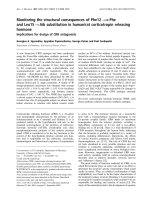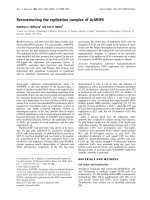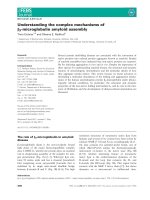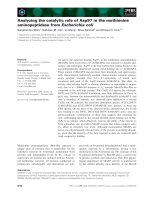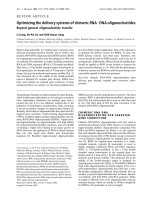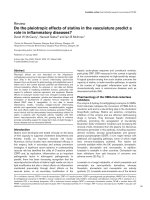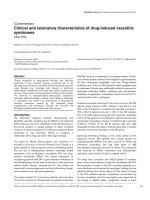Báo cáo y học: "Elucidating the molecular characteristics of organogenesis in human embryos" potx
Bạn đang xem bản rút gọn của tài liệu. Xem và tải ngay bản đầy đủ của tài liệu tại đây (228.95 KB, 3 trang )
Embryogenesis is a process by which embryonic cells
responding to extrinsic signals lose their totipotency -
their ability to develop into any cell type - and gradually
restrict their development potential to a specific lineage.
Mammalian embryogenesis starts when the totipotent
zygote divides and its descendants progressively restrict
their development potential to become either extra-
embryonic tissue or inner cell mass. Inner mass cells are
the pluripotent progenitors from which the entire
embryo, other than some extraembryonic tissues, will be
derived. During gastrulation, pluripotent progenitors
further confine their fates to one of the three primary
germ layers (ectoderm, mesoderm or endoderm). After
gastrulation, organogenesis starts with the formation of
organ primordia and the subsequent differentiation of
various cell types within those organs.
Anatomical aspects of mammalian embryogenesis have
been the subject of detailed morphologic characterization
over the centuries. e molecular profile underlying this
process has been a focus of research more recently, but is
still poorly understood. For example, the genes that
maintain the pluripotency of progenitor cells and that
regulate the stepwise differentiation of progenitors into
various cell types are only now starting to be identified.
Because this research is mostly done in model organisms
such as the mouse, it is important to verify that such
results extend to humans, and so could eventually be
considered for clinical application. Because of obvious
ethical concerns, human embryonic tissues are hard to
obtain; therefore, our ability to extrapolate knowledge
from mice to humans is limited.
The human embryo transcriptome
With some of the above problems in mind, the genome-
wide transcriptomic profiling of early post-implantation
human embryos, published recently in Developmental
Cell by Fang et al. [1], will be particularly valuable.
Human embryos from six consecutive Carnegie stages
(S9 to S14), which cover the first third of the period of
organogenesis, were used for this analysis. Carnegie
stages for human embryos are defined by external and
internal anatomical developmental criteria and run from
stage 1 (zygote) to stage 23 (around 56 days gestation).
During stages 9 to 14 and following the completion of
gastrulation, the neural plate folds to form the neural
tube and brain, and structures and organs such as
somites, heart and limb buds start to develop. Embryos at
these stages were pooled for Affymetrix expression
profiling to minimize variation and were run in triplicate
for consistency. Not surprisingly, the authors found that,
as with the transcriptome of early mouse embryos [2],
the most dramatic change in gene-expression profile
occurred as the human embryos completed gastrulation
and initiated organogenesis [1] (around embryonic day 8
(E8.0) in mouse and at the S9-S10 transition in human
embryos). is drastic change at the transcriptome level
from S9 to S10 is most likely to be because numerous
organ primordia start to develop between S10 and S12
[1]. Using available data-analysis resources, including
gene clustering and enrichment analysis, the authors
identified six clusters (clusters 1 to 6) of genes displaying
similar expression patterns. Clusters 1, 2 and 3 were
similar in that the expression of their genes appeared to
be gradually repressed as development proceeded,
indicating a gradual decrease in ‘stemness’. Concomitant
with the increasing diversity of cell types, the expression
of genes in clusters 5 and 6 (which included numerous
transcription factor genes) gradually increased; these
clusters include a significant number of genes that have
been identified as organogenesis-specific in mice [2].
Abstract
A transcriptomic analysis of early human
organogenesis reveals the molecular signature of
these processes and provides a valuable resource
for identifying and comparing crucial regulators of
mammalian embryogenesis.
© 2010 BioMed Central Ltd
Elucidating the molecular characteristics of
organogenesis in human embryos
Xin Geng and Guillermo Oliver*
R E SE AR C H H IG HLI GH T
*Correspondence:
Department of Genetics and Tumor Cell Biology, St Jude Children’s Research
Hospital, 262 Danny Thomas Place, Memphis, TN 38105-3678, USA
Geng and Oliver Genome Biology 2010, 11:130
/>© 2010 BioMed Central Ltd
Using a phenotype-gene ontology analysis, Fang et al.
also determined that defects in genes in clusters 1
through 3 were, in general, associated with embryonic
lethality and defective embryogenesis, but rarely with
genetic disorders, whereas defects in genes in clusters 5
and 6 were mainly related to postnatal lethality, various
organ defects and multiple genetic disorders.
A valuable aspect of this work is that it will enable
direct comparisons of available mammalian transcrip-
tomes. is type of comparative analysis is highly rele-
vant, considering that mice are one of the main experi-
mental models but humans are the targets of potential
diagnostic and therapeutic approaches. Although
humans and mice share 85% of their genes and undergo a
similar process of embryogenesis, differences in gene
regulation are most likely the leading cause of obvious
differences between species [3]. Zhang et al. [4] recently
highlighted some important species-specific differences
in the role of the transcription factor Pax6 in the
specification of the neurectoderm - the ectodermal cells
that will develop into the animal’s nervous system. ey
determined that although Pax6 activity is not required
for neuroectoderm specification in mice, its expression
follows that of the transcription factor Sox1, an early
marker for neuroectoderm. Interestingly, in humans the
situation is the converse - that is, a specific isoform of
PAX6 is expressed before SOX1 and is required for
neuroectoderm specification. Zhang et al. argue that the
early expression of PAX6 in humans (similar to their
previous results with rhesus monkey embryonic stem
cells), may have been a step in the evolution of the highly
evolved forebrain of primates [4]. In their study, Fang et
al. [1] identified a set of genes that are expressed early in
human embryonic development but have not yet been
implicated in early mouse development. In future studies,
it will be important to determine whether these findings
implicate important species-specific differences in the
regulation of organ development.
Charting the loss of pluripotency
Fang et al. also took advantage of the dataset they gener-
ated to compare the gene-expression profile of human
embryos with that of human embryonic stem cells
(hESCs) maintained in culture. ey found that approxi-
mately 20% of the genes in the clusters whose expression
was decreasing at S9 to S11 (when organogenesis is
beginning and pluripotency is being lost) are also
expressed in hESCs, and that many of these genes are
likely to be regulated by pluripotency-promoting trans-
cription factors such as POU5F1 (OCT4), SOX2, and
NANOG. In these clusters, pluripotency-promoting
genes are coexpressed with differentiation-promoting
genes that are most likely involved in the initiation of
organogenesis. A similar expression pattern was observed
during the transcriptome analysis of early mouse
embryo genesis, in which pluripotency genes were found
to be coexpressed with the regulators of gastrulation.
ese results validate the gene-expression data collected
from studies of hESC differentiation in vitro. At the early
stages of hESC differentiation, pluripotency-promoting
and lineage-specific genes are coexpressed (lineage
priming). As the expression of pluripotency genes wanes,
the cells gradually lose their ability to self-renew and
differentiate into specific cell types [5]. Consistent with
this notion, as development proceeds, genes in clusters 5
and 6 (expressed during S12 to S14) - which are most
probably involved in the differentiation of various cell
types and the formation of organs - become upregulated.
During S12 to S14, structures such as the nervous system,
the heart and the somites develop further; meanwhile,
the primordium of other structures, such as lungs and
ureteric buds, start to emerge. ese genes are under-
represented in hESCs and are likely to be regulated by
organogenesis-related transcription factors such as the
heart-specific NKX2-5, the skeletal-specific SOX5, the
nervous system-specific OCT1 and BRN2, and the
muscle-specific MEF2.
Although transcriptome analysis will be invaluable to
researchers trying to understand the early stages of
mammalian organogenesis, it is not without limitations.
Transcriptional status alone is not a sufficient indicator
of a particular gene product’s activity; protein expression
can also be regulated at the translational level and by
numerous posttranslational modifications and protein-
protein interactions. For example, NKX2-5 belongs to
cluster 3 and its expression is dramatically upregulated
from S9 to S10; however, its target genes are only
enriched in clusters 5 and 6 (expressed during S12 to
S14). Similarly, although the relative expression levels of
SOX5 RNA do not change during early organogenesis, its
target genes are enriched in clusters 5 and 6. To overcome
these limitations, at least partially, Fang et al. have
constructed a molecular network assembling the inter-
acting genes. Because this network analysis is mostly
hypo thetical, complementary approaches such as prote-
omics, and even more importantly, hypothesis-driven
research, will be necessary to validate these results.
Human organogenesis starts at Carnegie stage 9 and
ends at around stage 23. e study from Fang et al. covers
the first third of human organogenesis from Carnegie
stage 9 to stage 14. A complementary study using a
strategy similar to that of Fang et al. has analyzed the
transcriptome of human embryos from Carnegie stage 10
to stage 23, which, combined with the study from Fang et
al., covers the entire period of organogenesis in human
embryos [6]. Yet other studies have analyzed the trans-
criptomes of human oocytes, hESCs and human pre-
implantation embryos (blastocysts) [7-9]. A few missing
Geng and Oliver Genome Biology 2010, 11:130
/>Page 2 of 3
pieces, such as the gene-expression profile of the human
gastrula, will help complete the molecular characteri za-
tion of early human embryogenesis. ese valuable
resources will help elucidate the basic principles of
embryogenesis, expand our understanding of species-
specific differences during development, and eventually
help engineer hESCs in culture for therapeutic purposes.
Published: 27 August 2010
References
1. Fang H, Yang Y, Li C, Fu S, Yang Z, Jin G, Wang K, Zhang J, Jin Y: Transcriptome
analysis of early organogenesis in human embryos. Dev Cell 2010,
19:174-184.
2. Mitiku N, Baker JC: Genomic analysis of gastrulation and organogenesis in
the mouse. Dev Cell 2007, 13:897-907.
3. Waterston RH, Lindblad-Toh K, Birney E, Rogers J, Abril JF, Agarwal P, Agarwala
R, Ainscough R, Alexandersson M, An P, Antonarakis SE, Attwood J, Baertsch R,
Bailey J, Barlow K, Beck S, Berry E, Birren B, Bloom T, Bork P, Botcherby M, Bray
N, Brent MR, Brown DG, Brown SD, Bult C, Burton J, Butler J, Campbell RD,
Carninci P, et al. Initial sequencing and comparative analysis of the mouse
genome. Nature 2002, 420:520-562.
4. Zhang X, Huang CT, Chen J, Pankratz MT, Xi J, Li J, Yang Y, Lavaute TM, Li XJ,
Ayala M, Bondarenko GI, Du ZW, Jin Y, Golos TG, Zhang SC: Pax6 is a human
neuroectoderm cell fate determinant. Cell Stem Cell 2010, 7:90-100.
5. Laslett AL, Grimmond S, Gardiner B, Stamp L, Lin A, Hawes SM, Wormald S,
Nikolic-Paterson D, Haylock D, Pera MF: Transcriptional analysis of early
lineage commitment in human embryonic stem cells. BMC Dev Biol 2007,
7:12.
6. Yi H, Xue L, Guo MX, Ma J, Zeng Y, Wang W, Cai JY, Hu HM, Shu HB, Shi YB, Li
WX: Gene expression atlas for human embryogenesis. FASEB J 2010,
doi:10.1096/.10-158782.
7. Kocabas AM, Crosby J, Ross PJ, Otu HH, Beyhan Z, Can H, Tam WL, Rosa GJ,
Halgren RG, Lim B, Fernandez E, Cibelli JB: The transcriptome of human
oocytes. Proc Natl Acad Sci USA 2006, 103:14027-14032.
8. Assou S, Le Carrour T, Tondeur S, Ström S, Gabelle A, Marty S, Nadal L,
Pantesco V, Réme T, Hugnot JP, Gasca S, Hovatta O, Hamamah S, Klein B, De
Vos J: A meta-analysis of human embryonic stem cells transcriptome
integrated into a web-based expression atlas. Stem Cells 2007, 25:961-973.
9. Dobson AT, Raja R, Abeyta MJ, Taylor T, Shen S, Haqq C, Pera RA: The unique
transcriptome through day 3 of human preimplantation development.
Hum Mol Genet 2004, 13:1461-1470.
doi:10.1186/gb-2010-11-8-130
Cite this article as: Geng X, Oliver G: Elucidating the molecular
characteristics of organogenesis in human embryos. Genome Biology 2010,
11:130.
Geng and Oliver Genome Biology 2010, 11:130
/>Page 3 of 3


